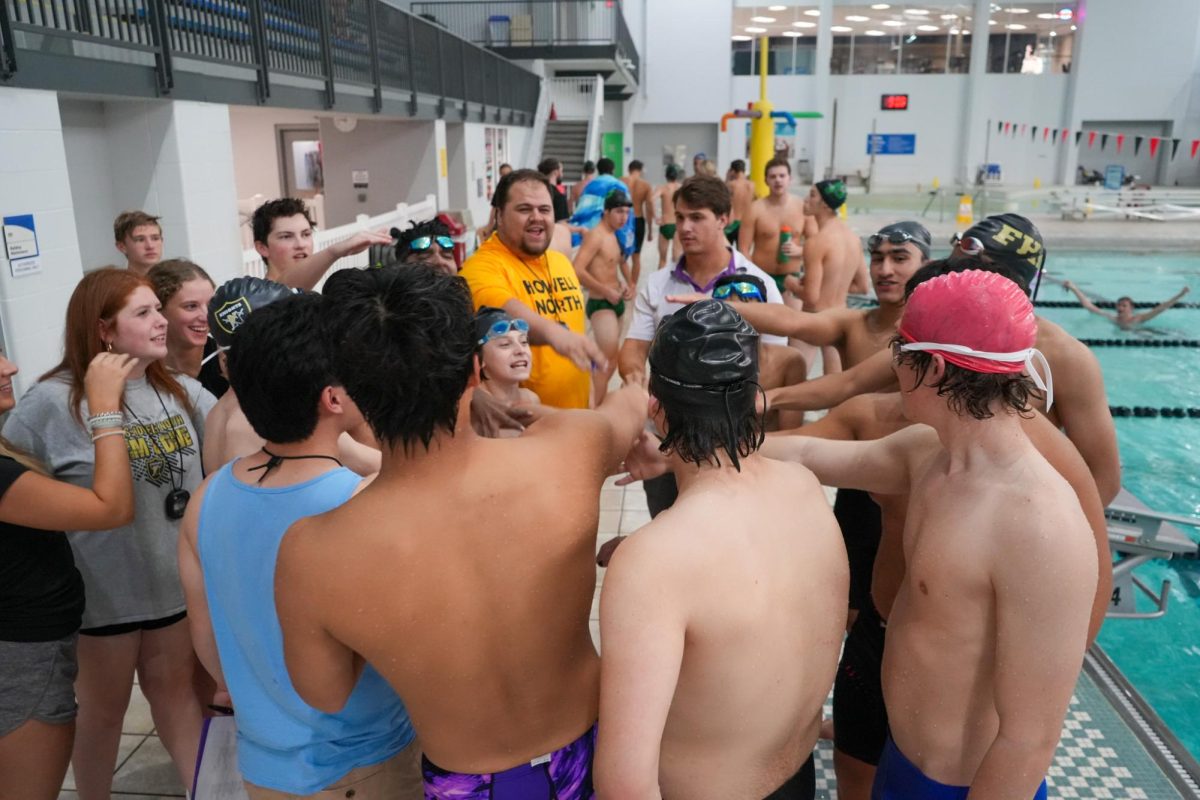Shawn Farrar’s main sport in his life was swim. In his professional career, he was a D1 athlete for swimming at Western Illinois University and he knows what competing at a high level looks like. As a result, when track needed help, Farrar took the opportunity to assist the team with his prior knowledge despite the differences in each sport. Farrar’s involvement has expanded to coaching sprinters and he does a variety of things for them.
“I just do whatever they need me to do,” Farrar, who also teaches Chemistry at FHN, said. “Whether it’s splits, watch technique, or watch exchanges. I’ll help give the workouts, and if they [other coaches] have been gone for certain meets, I can stay behind or run stuff with JV. I just do whatever they need me to do.”
Farrar has been coaching since he was 15. He started coaching swimming to little kids and soon moved up to older ages. Farrar has no prior experience with coaching track, but in his opinion, track and swim share similar traits.
“They’re pretty similar,” Farrar said, “The only difference is you have to work on a lot more fundamentals in swim, like techniques and stuff like that, just because there’s so many different strokes. And, well, if you get super exhausted in a track meet, and you stop running you’re on the ground, but in swim if you stopped swimming you sink. So, you have to go over a lot more technique…but there’s a lot of comparables”
Farrar has an extensive knowledge of swimming and competitive sports. He incorporates his knowledge of swim into his coaching for track.
“There’s certain little nuances that kind of carryover,” Farrar said. “Like for block starts, the methodology is you want to make sure that you’re pushing off with the most power from your lead foot. You want to make sure your weight is pretty shifted forward and nice and balanced. But then as soon as the race starts, you want to push off with one foot really hard. The only difference is when you want to throw your body forward into the water. In track, you want to gradually get up. So, I just try to find some comparables, when I can.”
Student athletes feel Farrar has been a welcome addition to the team. Freshman Danielle Westihoff is a new sprinter for track. She shares her experience with Farrar.
“Coach Farrar is someone that you can joke around with and always ask advice from,” Westihoff said. “He is always watching for the small things. One thing he did that was most helpful to me is he helped me get better with my block starts since he noticed me struggling.”
Students aren’t the only ones welcoming the change, coaches are as well including fellow track coach Joseph Brocksmith.
“He’s awesome at writing down times on the clipboard,” Brocksmith said. “He can run a mean stopwatch when he’s taking those times. And he’s very observant. I’ve watched him observe the students on the stands one time during our GAC’s and stuff. He’s very committed to his athletes.”
Farrar finds coaching to be fulfilling, regardless of what it is, whether it be track or swim.
“I just like helping kids succeed, reach their goals and help them push themselves,” Farrar said.
Farrar’s experience is not an uncommon one, but adapting may be difficult for other coaches. Farrar gives advice to coaches wanting to branch out of their sphere.
“Just be open minded,” Farrar said. “At the end of the day, coaching is coaching. You have to learn the rules, but still kids are kids, you just want to be there to help them learn, grow and get better.”






![Boys Swim Competes in Prelims for GAC’s [Photo Gallery]](https://FHNtoday.com/wp-content/uploads/2024/11/BoysSwimGACS_11.4.24_Dunham-9-e1731089788337.jpg)
![Boys Swim and Dive Team Win Second Place At GAC Meet [Photo Gallery]](https://FHNtoday.com/wp-content/uploads/2024/11/MZ-Swim-and-Dive-GAC-11.05-16-1200x800.jpg)
![Boys Swim and Dive Win Second Place Against Francis Howell Central [Photo Gallery]](https://FHNtoday.com/wp-content/uploads/2024/10/Swim-and-Dive-10.28.24-MZ-FINAL-5-1200x800.jpg)
![FHN Holds Annual Senior Night On Home Turf [Photo Gallery]](https://FHNtoday.com/wp-content/uploads/2024/10/IMG_0837-1200x674.jpg)
